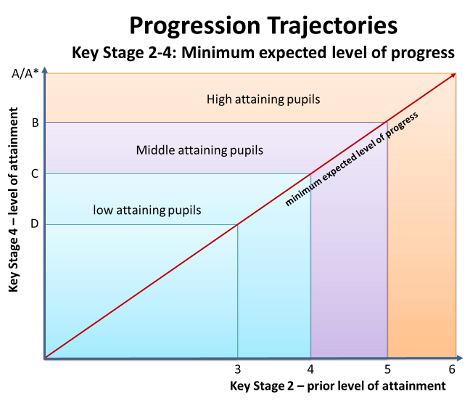I work with two fantastic middle leaders. Both support me whole heartedly and their feedback is always well considered. In preparing a whole school, whole year, data monitoring calendar I asked if one of my lines to proof both the document and the monitoring tasks. These serves two purposes. The first, it shows my colleagues that I value their opinion. Second, they ask great questions, on occasions they expose a presumptions we hold as senior leaders, and they also make valued suggestions which demonstrate they are first class school leaders themselves.
In proofing the monitoring document, a number of coded data items were matched more accuractly between data sources and monitoring forms, one missing data field was identified and most importantly one key questions posed. Do staff know what all these terms mean? So over the past few days I tweeted a request for data gurus to share their data glossaries with me to no avail. Today I got stuck into the job and attempted to write a glossary accessible to all staff though aimed at our Directors of Learning, to support their use of the data monitoring calendar documents and SISRA.
Attainment and Prior Attainment – Raw, grade or exam result or points score.
The main indicators included in the performance tables are the percentages of students achieving:
- 5 or more A*-C grades at GCSE or equivalent;
- 5 or more A*-C grades at GCSE or equivalent including English and mathematics GCSEs; the English Baccalaureate;
- expected level of progress in English;
- expected level of progress in mathematics;
- English and mathematics GCSEs at grades A*-C;
- 5 or more A*-G grades at GCSE or equivalent;
- 5 or more A*-G grades at GCSE or equivalent including English and mathematics GCSEs.
Also we collect
- 1 A / A*
- 3 A / A*
- Capped best 8 point score (best 8 GCSE or equivalent grades).
- Total points scores
| GCSE Grade | A* | A | B | C | D | E | F | G |
| Points | 58 | 52 | 46 | 40 | 34 | 28 | 22 | 16 |
level as their attainment.
Progress – Measures of progress are typically collected at the transition between key stages and refers to the difference between entry level/grade and current level/grade.
Achievement – Achievement is an OFSTED judgement which takes into account both attainment and progress.
Targets – targets can be set through varying methodologies. We based our targets on FFT estimations taking into account.
FFTd – Fischer Family Trust produces ESTIMATES of likely attainment. They are called estimates, not predictions or targets, as they provide an estimate of what might happen if your students make progress that is line with that of similar students in previous years. They are for the most part, based upon prior attainment in core subjects. Hamble Community Sports College uses Type D which is based upon the progress made by the top 25% of schools with similar contexts.
Predicted – Predicted grades at Hamble Community Sports College are teacher assessments and should be based on robust evidence.
Level of Progress – Defines the progress made by students between key stages. The expected level at Key Stage 2 is Level 4 and the expected level at Key Stage 4 is grade C at GCSE or equivalent. GCSE grades are given notional levels as shown in the diagram below.
| GCSE Grade | A* / D* | A / D | B / M | C / P | D | E | F | G |
| Level | 6 | 6 | 5 | 4 | 3 | 2 | 1 | BN |
*With students making 2 level of progress at Key Stage 3.
For how to dealing with BN see ‘Inexorable-world-of-data.’
Notional Levels for GCSE grades in Maths and English
Between Key Stage 1 and 2 students are expected to make at least 2 National Curriculum levels of progress. From Key Stage 2 to 4 students are expected to make 3 levels of progress.
Value Added – Value added compares students actual results with predictions derived from all students with the same level of prior attainment.
SEN A – School Action – a teacher identifies a child with SEN and provides interventions.
SEN P+ – School Action Plus – as with school action, but with help from external services. (School Action Plus is not necessarily a more significant learning challenge than School Action).
The proportion of students with SEN without a statement achieving achieved 5 or more A*-C grades at GCSE or equivalent including English and mathematics in 2011 was 24.7%
SEN S – The Local Authority provides written statement of SEN needs of the child.
The proportion of students with SEN statement achieving 5 or more A*-C grades is 8.5 %.
CIC (LAC) – Children in care of Looked after Children
Of the children looked after continuously for 6 months during the year ending 31 March 2011: At Key Stage 4, 13.2 per cent achieved the 5+ A*-C at GCSE or equivalent including English and mathematics compared with 12.0 per cent in 2010.
FSM – Free School Meals. Free School Meals are offered to children of families who are in receipt of Employment and Support Allowance (Income Related), Income Support, Income Based Job Seekers Allowance or Guaranteed Element of State Pension Credit.
34.6 % of students eligible for FSM achieved 5 or more A*-C grades at GCSE or equivalent including English and mathematics GCSEs, compared to 62.0 % of all other students.
EAL – English as an additional language
Narrowing the Gap – The term used to describe the efforts to reduce the deficit between the outcomes between groups and national data, in particular, for vulnerable and excluded children.
Girls continue to outperform boys: 61.9 per cent of girls achieved 5 or more A*-C grades at GCSE or eq
uivalent including English and mathematics GCSEs compared with 54.6 per cent of boys.
Residuals – the difference between the outcome points score in the subject and the average score in all other subjects. It is an indicator of how well the student has performed in your subject compared to others subjects. SISRA calculates the average APS for a subject and compares this with the average APS obtained in all subjects by the students taking that subject, including that subject.
APS – Average point score – where grades are convert to points.
ATPS – The average total point score is calculated by dividing the total number of points achieved by pupils at the end of KS4 by the number of pupils on roll at the end of KS4.
Ethnicity – The proportion of students achieving 5 or more A*-C grades at GCSE or equivalent including English and mathematics GCSEs continues to vary between different ethnic groups.
- Pupils of any white background achieved broadly in line with the national level
- Pupils of any black background achieved below the national level although the gap is narrowing.
- Pupils from an Asian background performed above the national level
- Chinese students are the highest attaining ethnic group
KS2 Banding (UML) – students are banded low, middle or high based on KS2 attainment.
- Low attaining = those below Level 4 in the KS2 tests (an average points score in English, Mathematics and Science of less than 24); (approx 20% nationally)
- Middle attaining = those at Level 4 in the KS2 tests (an average points score between 24 and 29.99); (approx 50% nationally)
- High attaining = those above Level 4 in the KS2 tests (an average points score of 30 or more). (approx 30% nationally)
Note – not all ‘M’ are the same. The difference in academic achievement at secondary school between these pupils and those who manage a ‘good’ level 4 (level 4a) and a ‘weak’ level 4 (level 4c) is significant. 81% of those who secured level 4a in English and mathematics went on to secure at least 5 A*-C GCSEs, compared to only 47% of those who secured level 4c.
- This year “banding by prior attainment” has been introduced to the analysis:
| pts | Level | fine scores | sub-levels |
| 15 | Level 2 | <18 | |
| 21 | Level 3 | so 18-24* | 18-20 = 3c; 20-22 = 3b; 22-24 = 3a |
| 27 | Level 4 | so 24-30 | 24-26 = 4c; 26-28 = 4b; 28-30 = 4a |
| 33 | Level 5 | so 30+ | 30-32 = 5c; 32-34 = 5b; 34+ = 5a |
*Note that 18-24 is actually 18-23.99 etc
Volume Indicator – Qualifications are compared to the size of a GCSE to determine a volume indicator or how many GCSEs a qualification worth. For example, a GCSE in vocational subjects (Double Award) is twice the size of a GCSE so would have a volume indicator of 2.0, a short course GCSE would be 0.5.
Quantitative data – numerical or statistical data that gives details of achievement. Quantitative data tends to be centred on pupil outcomes and it is often used to inform expectations or to evaluate performance across groups of pupils, subjects or schools.
Qualitative data – data that emphasises meanings, experiences and descriptions. The data is often what has been said or observed.
Summative pupil assessment – usually expressed in grades or levels and it forms the basis of most quantitative data. Summative pupil assessment is often referred to as assessment of learning.
Formative assessment – the ongoing use of data to improve learning. Formative assessment is a continuous process that happens between teachers and learners. It is a central element of assessment for learning.
Comparable Outcome – Proportion of students achieving each grade stays the same.
Comparable Performance – Demand of the knowledge, skills and attitudes that students must show in exams stays the same.
Threshold Measures: where a pupil has to reach a certain standard or threshold to count; this can then be expressed as percentage of cohort etc. e.g. percentage of pupils gaining 5A*-C grades .Note that in practice
a) the results of a few pupils can affect a threshold measure e.g. those around C/D borderline for %A*-C, and
b) one element of a multiple threshold can dominate e.g. in practice there is very little difference between:
%5A*-C incl En+Ma (ave across schools = 56.0%) and %A*-C in GCSE En+Ma (ave across schools = 56.3%)
Average Measures: where each pupil gets a score, and these scores are then averaged across the cohort. Average KS2 points score on entry. Note that an average measure can be significantly affected by outliers (i.e. individual scores which are very different from the others, e.g. an able pupil in hospital who could score -500 on Overall VA outweighing lots of +10, +20 etc. The issue can be crucial if looking at smaller sub-groups e.g. SEN, FSM, – but this is where the scattergrams with colour-coded subgroups in the new RAISE can be very helpful to show outliers. Schools should highlight this impact in any analysis.

Unvalidated, validated and final data – Unvalidated Key Stage data do not reflect changes that may have been requested as part of the Achievement and Attainment Tables checking exercise (Late Sept / early Oct).
Validated data incorporates changes that have been requested and accepted as part of the checking exercise. These will usually be the result of successful revisions and re-marks. If, however, the school was involved in a late appeal or an appeal was ongoing at the time of production of the data these changes may not be reflected.
Final data are released for Key Stage 4 once all changes and appeals have been processed and the KS4 database has been closed. Note that there is usually no final data release for Key Stage 2 in RAISEonline.
Percentile Rank – the rank assigned to maintained secondary schools nationally from 1 to 100, with 1 being the highest value-added score and 100 the lowest. Percentile ranks are a useful way of interpreting value added at your school.
Confidence Interval – determine a range of values that we can be 95% confident the school’s CVA score falls between.
| Proportion | Description |
| 97–100% | Vast/overwhelming majority or almost all |
| 80–96% | Very large majority, most |
| 65–79% | Large majority |
| 51–64% | Majority |
| 35–49% | Minority |
| 20–34% | Small minority |
| 4–19% | Very small minority, few |
| 0–3% | Almost no/very few |
If you are a data guru, and you think I have missed something, or could improve upon my glossary terms, do let me know.
Should you want to talk monitoring calendaries, drop me a comment.
[qr_code_display]


This is great Kristian.
Consider it stolen for use at my school!
Pleased that someone other than myself and our school can benefit from the glossary, let me know if there are any omissions.
Great list Kristian. Can’t think of any obvious omissions.
We’re looking to have a big focus on Levels Progress in as many subjects as we can as it’s the biggest leveler of all and we hope will stop us focussing too deeply on lots of the other measures which only exist for league table purposes.
Measuring levels progress without a specific KS2 score for your subject isn’t so simple though!
Dan
No it’s not. What do you intend to use?
Also wasn’t aware of the Ofsted descriptors – but they’ll come in handy for updating our SEF this week – much appreciated!
These were a late addition. Very useful for all teams. Thanks to DHT at Comberton Village.
Another point of thought……
…at what point does a group become statistically significant? If you have 6 Black Caribbean pupils can anything be read into their % 5A*-C for instance? What point to we stop counting?
That’s another good point. I’m not sure when data sets for a specific group becomes statistically questionable, although I’m sure there is a coefficient value for that. I wonder if more experienced data gurus would care to comment? Of course it is always important to triangulate any data, maybe we just have to be more investigated
Pingback: Learning as I go | Kristian Still's Blog
I was reading about school data somewhere which made reference to Average Point Score (APS), but then EAPS and MAPS – what are these?
I would suggest English average point score and maths average point score. It always seems so obvious once you know the answer. I am so glad that someone is making good use of the information here. I’ll be sure to add those two acronyms.